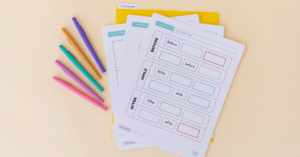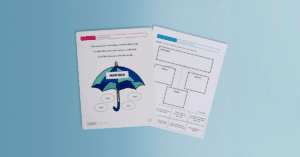At the SLP Summit on January 30th, I presented 3 simple routines to streamline your therapy planning!
Missed us live? The replay is available until February 19th!
There were a lot of questions, so let’s take some time to answer them here! 💛
Literacy-Based Therapy Framework
First, we reviewed Dr. Ukrainetz’s 5-step literacy-based therapy framework.
Check out this Instagram post for a quick overview of literacy-based therapy.
And now let’s dive into the questions…
Do you write goals specific to this framework?
I don’t! I write goals based on the skills that my students need support with. Any goal can be targeted using a literacy-based approach.
What ages do you use this with?
This framework applies to school-age children (preschool through 12th grade)!
How would you use the literacy based framework for preschool students as they are not totally equipped with literacy knowledge or letters?
Literacy knowledge is not required! The activity throughout the framework can be done 100% verbally. No reading is required!
Would you collect data in Step 1 (Pre-Story Knowledge Activation)?
The activities in Step 1 (and Steps 3, 4, and 5) are language rich. We can target any goal using these activities.
Where do you find virtual fields trips for Step 1 (Pre-Story Knowledge Activation)?
I find my virtual field trips on YouTube!
How would you use a KWL Chart with younger childrens (ages 3-5) in Step 1?
A KWL chart might not be appropriate for all ages. Semantic mappingcould be a better activity choice!
Do you pause during Step 2 (Reading) to make comments and ask questions to keep them engaged?
Absolutely! I don’t specifically target goals during this step, but I do use whatever strategies needed to keep students engaged!
During Step 2, do you read the whole book in one day or only a specific number of pages per session?
I read the whole book in one session! I select picture books/texts that can be read in 5 minutes or less.
During Step 3, do you teach how to answer questions appropriately?
I use comprehension activities to target the students’ goals. That may or may not include appropriate responses to questions!
During Step 3, do you have any recommendations for older students who struggle with reading?
I may support literacy in my therapy sessions, but being able to read a text is not a necessary step! The text may be read aloud (by me or another student), and all activities can be completed using only oral language.
During Step 4 (Focused Skill Activities), do you go through the book to find vocabulary words?
SLP Now does this for you! All of the vocabulary targets are listed in the “Targets” tab for any given unit.
Do you have a template for Step 5 (Parallel Story)?
Yes! If you are a member, click here to access the template.
Is there a trick to use this with mixed groups when some in the group attend more sessions per week than others in the same group?
The students who are being seen multiple times a week likely need more support! I would use those sessions to dive into the skills that those students need more support with.
What are your favorite picture books?
Here is a list of my favorite picture books!
Do you use the same book the teacher is using in class for that unit?
That is a fabulous idea, and I have had a lot of success incorporating classroom texts in my therapy sessions.
Do you have any recommendations for texts for older students?
Yes! I love using ReadWorks for fiction and nonfiction articles.
What about students you see multiple years? Do you use the same books for multiple years?
I tend to choose different units. SLP Now has over 400 literacy-based therapy units, so you have plenty to choose from!
When working with mixed groups, how do you hit the appropriate number of articulation trials with this model?
I like to target articulation goals separately (whenever possible) using a “quick articulation” model. (One example of this is 5-Minute Kids.) If that isn’t possible, I get creative! Click here for 6 activity ideas to target articulation using books. SLP Now also has articulation cards (with words from the text) to make this even easier!
I have a bunch of students with social/behavioral goals. How do I target those goals if they are grouped with kids with different goals?
This is the ideal set up! Having access to peer models is one of my favorite benefits of mixed groups. I would target social language just like I would any other goal! I would take time to teach as needed–including the use of visual supports. Students then have the opportunity to apply the skill throughout the unit and across language-rich activities.
What is your favorite way to target grammar when using books?
I have a 3-hour course on grammar in the SLP Now Academy!
You can also check out these grammar blog posts.
How long should sessions be when using this framework?
The ideal session length (based on my experience) is at least 20 minutes!
Does this framework apply to one-on one or group settings?
You can use literacy-based therapy with individual students or groups. I’ve found that I do best with groups of 3 (or fewer).
Data Collection
Do you collect data each session for each child?
I do! My goal is to collect data on one goal per student per session.
How long do you spend on the probe during the session?
I have a very streamlined system, so it shouldn’t take more than a minute per goal. Here’s a quick video of the process to collect a probe.
Do you give the same probe every time?
I do! This helps me measure progress in a consistent manner. I rotate through the goals. If a student has 4 goals, each goal would be probed every 4 weeks. I also don’t provide any feedback while administering the probe, which helps reduce “learning” of the probe items.
What are the other students doing when you’re doing the probe with one student?
I recorded a podcast episode about how I like to start my sessions.
Do you give students the same probe? How do you control for them hearing the others’ responses?
If the students have the same goal, I may administer the same probe.
Do you provide feedback when giving probes?
I do not!
What would a daily SOAP note look like in SLP Now?
Here’s one example:
Amelia Bones participated in a literacy-based therapy unit (A Camping Spree With Mr. Magee) on 01/08/2024 from 9:00 AM to 9:30 AM in a group.
Goal: answer questions about narrative elements (character, setting, events)
When given a probe, Amelia achieved 20% accuracy (1/5 trials).
When given visual cues, Amelia achieved 80% accuracy.
Plan: Step 3
Everything was automatically populated. I just filled in the plan at the very end.
You can also customize your note template! Click here to see how that works.
SLP Now
Does SLP Now have Spanish resources?
Yes! We have a few Spanish units and handouts. We are working on adding more!
Does SLP Now have materials for all ages?
Yes! This article lists all of the goals and units that we offer for various ages.
How many therapy plans does SLP Now have?
We have over 400 units, including picture books, reading passages, fiction articles, nonfiction articles, vocational videos, and science experiments.
Where can I find the visuals for teaching story grammar?
If you are an SLP Now member, click here to access the visuals.
How do you use the SLP Now Sentence Pack?
An SLP posted a tutorial video in our member community.
Does SLP Now have a goal bank?
We do! It is built into our site.
Does SLP Now have virtual materials for virtual learning?
Yes! If you are a member, click here to access them.
Does SLP Now have activities for home/carryover?
Yes! If you are a member, click here to access them.
Is there somewhere in the SLP Now program that I would be able to enter the students’ exact goals from their IEP?
Yes! You can copy and paste your students’ goals into the platform. Here is a quick tutorial.
If you are an SLPA working under an SLP, is there a way to share this data together?
Yes! We added a new feature that allows you to share a caseload between an SLP and an SLPA.
Is SLP Now HIPAA compliant?
Yes! You can read more details here.
Is there a way to trial SLP Now?
Yes! You can sign up for a free trial here.
How do I access the Digital Binders?
When you sign up for an annual membership to SLP Now, you will receive the digital binders as a bonus!
If you are already an annual member who attended the SLP Summit, check your email for a link to redeem your binder!
As always, if you have any questions, don’t hesitate to reach out. Email us at hello@slpnow.com.




Reader Interactions